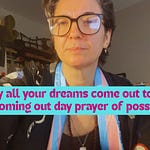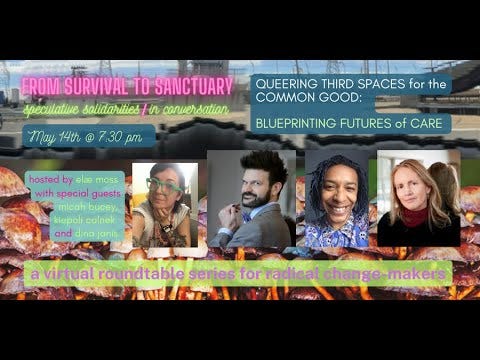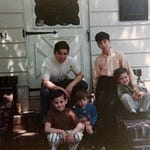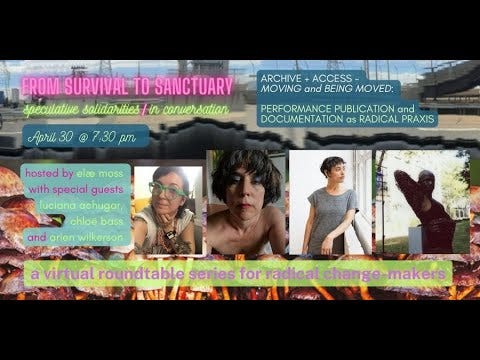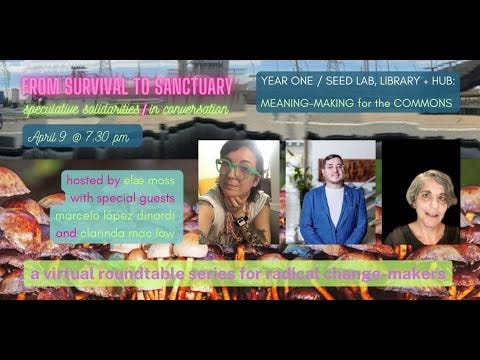For the last few weeks (and specifically since Aaron Bushnell’s moral, anti-imperial self-immolation) I’ve been thinking about what it means to burn ourselves alive. This isn’t a violent or graphic post — I’m sorry if I caught you off guard — but it is one in which I’m going to ask us (as I’m asking myself) to consider when and how we allow ourselves different kinds of death, in the courageous and unrelenting interest of life.
Perhaps that’s not what you expected on this substack. Perhaps you expected art news, updates, activism, maybe resources and tools. But I’m utterly not called to anything akin to “self-promotion” at this time. However, I am very, very interested in honest, vulnerable, interdependent connection — and the ways we share our stories, our work in the world, and our reflections on all of these things.
This is a time where I feel asked to begin over and over. To scrap, to burn, to pick up the pieces. Today’s offering is past efforts rendered ash, read like tea leaves, become story — in a way that I believe is truly hopeful, and which is perhaps the only way I feel comfortable writing, or expressing myself, anymore. And I’ve realized in these last weeks when I kept not posting here, even after intending to, that this is why.
Because, here or anywhere, I don’t want to perform — for you, for me, or for anyone. I don’t want this to be yet another kind of drag. Instead, I want to invite you in to the place I’ve found myself after a series of these deaths, and see if you, too, might want to consider a type of fire that might just save you.
Land keepers have utilized the strategy of prescribed burns to care for and retain the balance of ecosystems for millennia — until in many cases those who forcibly seized those lands outlawed these interdependent practices, foolishly labelling them as destructive. In California, for instance, intentional burning was outlawed beginning in 1850, before the state’s formation — with policies that stayed in place for over 100 years, much to the region’s detriment and endangerment. Now, slowly but surely, these practices are being recognized for the finely tuned mechanisms of care that they are — offering a parable for our own relationship to mutual aid with other-than-humans, and an opportunity to reconsider the very nature of ‘preservation.’
And: this is an opportunity to reconsider what we name and perceive as “violence” - what lenses we use when we miscategorize the medicine of a prescribed burn as dangerous, and how this crude translation threatens to obscure the fight for liberation. When and how do we need to watch out for mistaking the forms of revolutionary care that look like fire as harmful? When we understand that measured and meaningful destruction is a necessary part of ecological growth, what permissions open up?
To consider: What are you willing to burn down in order to seed the flourishing of what you want to see grow in its place? Conversely, what do you recognize you grasp tightly to, fearful that to release it might mean you risk losing this known quantity entirely… even when your heart and spirit seek something else?
Over these past few years (and then intensely in the past five months) I’ve drastically shifted my internal relationship to systemic expectations, “responsibility” and labor, as I’ve released conditioning around work and become far clearer on what my actual work in the world is. Sometimes, I’ve felt like helping others find frameworks for these shifts and releases is the most important thing I can do — hence, the building and articulating of Speculative Solidarities, for instance, and the creation of public protocol videos for their adoption and sharing, starting right at the eve of pandemic, in March 2020.
And yet I think that something hadn’t clicked, or broken, yet. There was still something holding me back — perhaps, as Ursula K. LeGuin tells us we might, I still believed in (or feared) on some level the inevitability of capitalism and its power structures, despite everything I’ve done to build and teach the building of alternatives. And so, once we went back into the world, even without meaning to, I put the drag back on. A sort of drag that’s familiar, but whose familiarity is anything but safe. This drag, institutional expectation drag, is the opposite of the release and freedom this form offers many performers, rather it’s a much more sinister type: where you are in danger of losing yourself, as you offer chameleon facets to others.
But that’s not true anymore. The costume chafes, my nervous system screaming that these spaces and seams aren’t safe. The process of healing can get you to a place which means you can’t, or won’t, accept certain behaviors or conditions anymore, even before a clear solution or path reveals itself — but ‘survival’ of the spirit and of the body have risen above the conditioning that taught me I needed to punish myself and accept systemic abuses to survive.
I’ve given myself a mantra to return to when I slip back into accepting the unacceptable. I remind myself that anyone or anything that I would lose in the process of taking care of myself (or others, or the ecosystem) is not for me. Perhaps this will provide some guidance or solace for you, too.
By choice, with a feeling of utter relief, I find myself solidly on the other side of some pretty significant lines in the sand, and I want to talk about it, not only make these moves on the DL. Essentially, I’m realizing how much I don’t want to pretend that what I’ve been calling my “big arc” is secondary, or absent… even if it comes with a risk. These days, what feels like a much worse risk is participating in the fallacy that my actual work—our work, as humanimals—is the work of reinforcing the status quo in any way. So: the burning, but with purpose.
What do I mean by the big arc? In a way I’d say it’s my big questions — the big questions — and then how we put the work of answering them into action every day. It’s what I’ve spent my whole life assuming everyone was here asking, so sure was I that to be human was, in fact, to ask these questions:
why are we here?
how do we do this?
how do we care for each other?
what forces are there beyond what I can see?
what is love?
what is faith?
and so on.
For me? this big arc takes the form of system design and maintenance, building clear tools and assisting in navigating system (and mind) overwhelm, conceiving of and producing events in coalition (like A People’s Fair for Palestine, in the video above) — thinking concretely about how solidarity can perform and become sanctuary, and moving to enact and build collective care, in the service of liberation for all beings and bodies. But it also takes the form of sweeping the floor and doing the dishes, quietly, at the edges of what might look more like “action,” because first and foremost I always always know that I am here to learn and listen.
To consider:
What is your “big arc”? If system or industry roles fall away, what do you understand as the work you are here to do on this planet in your lifetime? What if traditional formations of family fall away as well? What if anything might this change?
So, what happens after I set myself ablaze? Who notices? Is it a fire if I’m the only one who sees it lit? And what about after, in the rawness, in the ash? As is often the case, as I roll around the idea of my own composting through a sort of fire, I’m thinking about The Mushroom at the End of the World, and Anna Lowenhaupt Tsing’s productive framing of matsutake, fungal intelligence, and the evolutionarily critical role of ecosystem disturbance in — not only from humans, prior to and during the anthropocene, but as a cyclical occurrence directly spurring emergence and collaborative adaptation.
Teachers like matsutake, moss, orca, slime mold, and the human conduits who have introduced me to their intelligences have led me to a sort of courage sociocultural conditioning told me was unavailable to someone like me, which is to say, precarious. So have frequencies like that of Medicine Buddha, Tara, Mary Magdalene, Isa, and the spiritual work of contemporary faith leaders like Lama Rod Owens, calling us to find the work of the New Saints in ourselves.
One last profound teacher I’ll speak of today has been my own body — and its over 20 year battle with chronic, often impossible to treat and diagnose conditions. Why this? because being at times disabled has been the site of unavoidable, unpredictable, excruciating emergence. And because when my own ecosystem decides it’s time for its intelligence to pull rank over my conditioned mind, the mind-me is humbled into taking a seat.
Ecosystem, spirit, and body — my big teachers… which of course are deeply entangled! While resolutely acknowledging that their edges and definitions are unclear, I’m here to work with them, and then for the liberation of all beings while on this confounding planet! Everything else I either find a way to align within those frameworks or, at this point… I don’t do.
My big arc is a hopeful refusal. As I’ve recognized that it’s the only version of myself I’m interested in, it’s taken me to incredibly unexpected places — for instance, exploring the revolutionary potential in contemporary faith spaces and their infrastructure, for me and for all of us.
Right now, as part of this investigation, this means I’ve become a member of a “church,” surprising me as much as anyone! However: I explicitly do not identify as a Christian and I do not believe in an agentive, singular, “God.” Leaning on what I’ve learned from polyamory, I recognized that I could enter spaces with a healthy recognition of their failures and lack of capacity to be or offer everything from the jump — so after feeling unsatisfied by Sanghas, and knowing I was seeking something more resourced and structured, doing more active justice work in the world, I found a place that understands mutual aid, collective care, and the arts as faith in action.
What I am still seeking is to be in intentional, rigorous, collective partnership with others who identify and practice a sort of faith that includes mushroom as much (or more) than old-man-in-the-sky, who understand that all questions are spiritual questions, and who show up in the world every day dedicated to knowing that love is a verb.
My big arc says, because we are always, always, energy/consciousness/spirit inhabiting a body, to seek to understand ourselves is to acknowledge and reckon with the utter strangeness of this.
I’ll come back to all of this soon, sooty no doubt, as I continue to grapple with how to be, unabashedly, my self. These are process notes. It doesn’t have a goal as much as hypothesis, a gesture at how the recording of the getting-at-knowing may be as powerful or more than any claim to certainty. And a hope that in some way it can offer some necessary seed to someone, somewhere, sometime.
That’s the promise of documentation, after all, isn’t it?
With gratitude, in solidarity and possibility always.
Thank you for listening, for reading, for your presence here.
I welcome your thoughts, feedback, and reflections.
Until soon, ONWARD.
Elæ Moss
Brooklyn NY
March 2024
Notes, Links and Related Media:





